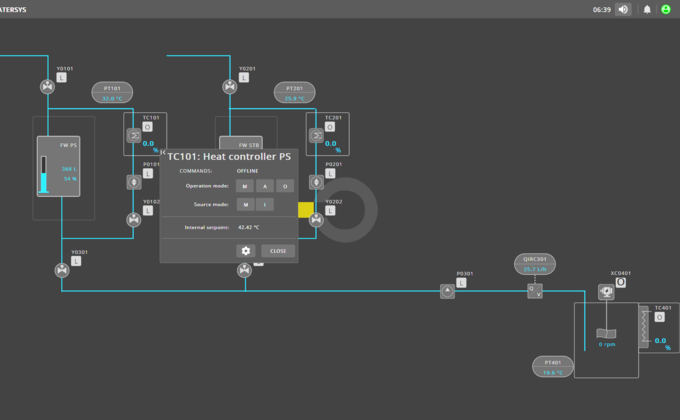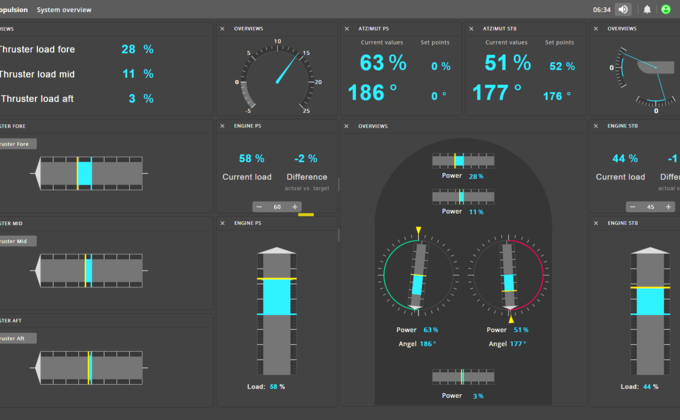
GERMAN MARINE EQUIPMENT 2021
Contribution in:
VDMA Special | Schiff & Hafen | Ship & Offshore | 2021/22
Generating software standards throughout the shipbuilding industry.
BACHMANN To create a software standard for the entire maritime industry, Bachmann – as part of the VDMA Working Group “MTP in Shipbuilding” – is working on modular automation systems in cooperation with institutes and suppliers.
There is a paradox facing today’s shipbuilding industry. While modularity is increasing in the structural aspects of the shipbuilding process, the use of modular software is still in its early stages. According to Ronald Epskamp, Maritime Business Unit manager at Bachmann electronic, it is time for a change: “Inter-system connectivity is extremely important. Many different equipment suppliers are involved with building a ship, but instead of the user working with 30 or 40 unconnected systems, each with different interfaces, it is much simpler and easier to implement just one HMI [Human Machine Interface] in the ship management system.” Bachmann’s participation in VDMA’s Working Group ”MTP in Shipbuilding” is going a long way to answer this problem. “Our goals are faster engineering, commissioning and integration – all with reliable solutions,” added Burkhard Staudacker, Bachmann key account manager. “With MTP (module type package), we can reach these targets.”
Image caption: Application imported from MTP files are immediately available in the HMI.
Standard meets challenge
Bachmann has cooperated with educational institutes and OEM suppliers to develop a modular automation system, and therefore a software standard for the entire shipbuilding industry. Using its atvise® scada platform, Bachmann has already carried out successful preliminary investigations to import MTP files from three different equipment manufacturers. Staudacker said: “Immediately after import, OEMs can control their equipment according to their existing visualisation. This allows users to maintain their existing screens, including graphics, icons, buttons, and design, according to their corporate identity.” The Bachmann system has implications for the entire supply chain.
For OEMs, MTP makes it easier to control the visual interfaces of sub-applications such as thrusters, gearboxes and other systems. “It’s as straightforward as installing a printer in your office. It also means full system approval, including electrical interfaces during the factory acceptance test,” said Staudacker. For the systems integrator, MTP export and import capabilities translate to cost reductions for engineering, PLC, visualisation and commissioning processes. “Moreover, the reduction of commissioning times is a major benefit for shipyards; for example, commissioning on board a cruise ship is reduced by up to 400 working days,” Staudacker added. However, the ultimate benchmark is the benefit for shipowners. Besides reduced service costs through fewer engineering and commissioning errors, the efficiency of the retrofit process is dramatically improved. By implementing a new system via MTP, owners are assured that the new, retrofitted equipment will ‘speak the same language’ as the existing ship management system.
Same look and feel
Ship bridge design faces a similar challenge. A bridge design should integrate multiple systems from multiple suppliers into one coherent and workable configuration. The reality is that, instead of being user-friendly, many bridges are often inefficient and can lead to errors. Epskamp said: “In choosing the best solution for its fleet, an owner may use several suppliers, all of which bring their own interfaces. But you have to consider the crew – their work is made much easier with a standardised framework and working environment throughout the fleet.” Bachmann’s collaboration with Norwegian design consortium OpenBridge addresses this problem with an open-source design framework. The aim is to create safe and efficient workspaces with seamless design and integrated technical systems. The framework is based on Bachmann’s atvise® scada software applied with numerous OpenBridge functions. One such function is four different levels of screen brightness: night, dusk, day and bright. This can be crucial, as Neels Schueder, Bachmann application engineer, explained: “If you have ever been in the wheelhouse of a ship at night, then you know that an overbright screen can really affect your eyes. This has a major impact on what you can see at sea.”
Image caption: Application created in the browser from widgets of the OpenBridge template
Tailor-made displays
In addition, an OpenBridge screen is characterised by display clarity, which can be tailor-made to the owner’s requirements. Schueder said: “There are many elements defined in OpenBridge. Crew members on the bridge can personalise applications and fine-tune the system according to personal preferences, for example with engine data, rudder position, or other navigational components such as maps.” Moreover, shipowners with a number of vessels can implement the same look and feel across the fleet. Bachmann has kept safety at the forefront of OpenBridge. Alarms are detailed to the extent that a user can immediately identify and locate a problem. This facilitates a clear and well-defined response, rather than the trial-and-error approach of ‘hot swapping’ hardware.
A further benefit of the Bachmann/OpenBridge collaboration is that it is based on open-source software. The only investment on the client side is the purchase of Bachmann’s atvise® scada software and training. “We hope that more people will start using OpenBridge – collaboration with our customers allows us to continuously develop new features,” Epskamp noted. “This will be a major advantage for clients in the future.”
Collaboration is key
For all its automation systems – including its work with MTP and OpenBridge – Bachmann’s collaborative philosophy strives to bring together a wide range of partners to share strengths and initiatives. Epskamp concluded: “We learn from shipowners and translate their visions into tangible automation solutions so that we can create high quality, fully-tested systems, reduce precious development and commissioning time, and become a driving force for automation in the maritime industry.”

